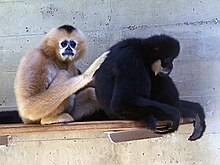Southern white-cheeked gibbon
| Southern white-cheeked gibbon | |
|---|---|
 |
|
| Male and Female | |
| Scientific classification | |
| Kingdom: | Animalia |
| Phylum: | Chordata |
| Class: | Mammalia |
| Order: | Primates |
| Superfamily: | Hominoidea |
| Family: | Hylobatidae |
| Genus: | Nomascus |
| Species: | N. siki |
| Binomial name | |
|
Nomascus siki (Delacour, 1951) |
|
 |
|
| Southern white-cheeked gibbon range | |
The southern white-cheeked gibbon (Nomascus siki) is a species of gibbon native to Vietnam and Laos. It is closely related to the northern white-cheeked gibbon (Nomascus leucogenys) and the yellow-cheeked gibbon (Nomascus gabriellae); it has previously been identified as a subspecies of each of these.
Members of the species are not a uniform colour; unweaned juveniles are a light brown, turning to black after weaning. Adult males remain black, but adult females are brown. The name of the species is taken from the male's facial markings, a large patch of white fur around the edge of the mouth - this distinguishes it from a male of N. leucogenys, which has the white in a streak along the cheeks. Females have a thin edging of white around the face.
The species lives in lowland broadleaf forest, with some populations living in forested mountainous areas. As with all gibbons, they are arboreal and frugivorous.
The original distribution covered an area of central Vietnam and central Laos, ranging from the Nam Theun (Khading) and Rao Nay rivers in the north (approximately 19th parallel north) to the Banghiang and Thach Han rivers in the south (approximately 17th parallel north). Between 19 and 20 parallel there appears to be an area of overlap or intergradation between N. siki and N. leucogenys.
Within its original distribution, the species is still common in the remaining large forest blocks in Laos, but in Vietnam the populations are scattered due to human encroachment on their habitat for logging and farming. Numbers are thought to have declined by 50% over the last 45 years, and the species is classed as endangered; it is legally protected in Vietnam, but this is not effectively enforced outside of protected areas. Hunting for food, traditional medicine and the pet trade is a serious threat to this species in both Laos and Vietnam.
...
Wikipedia

